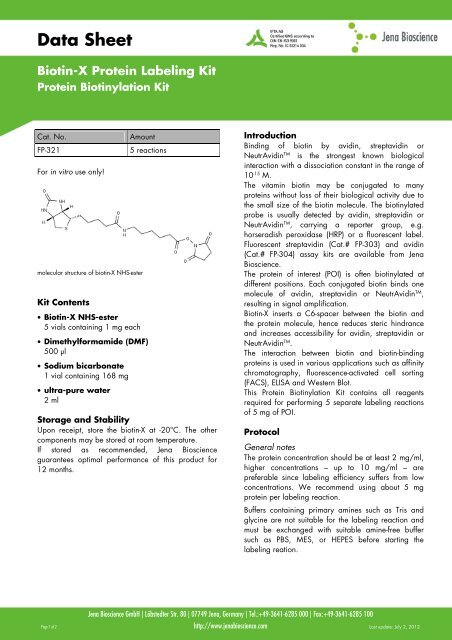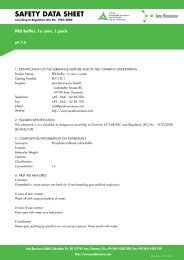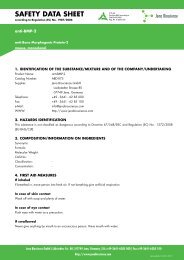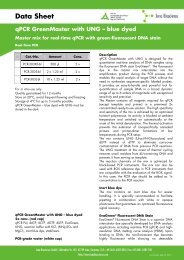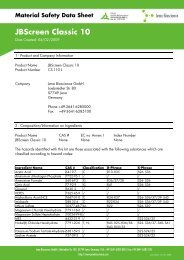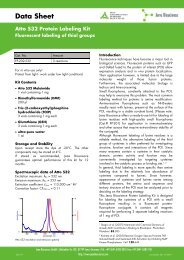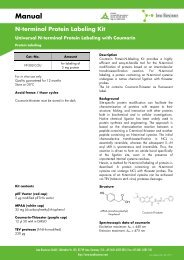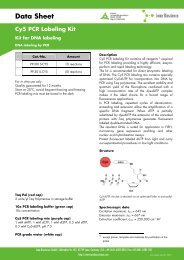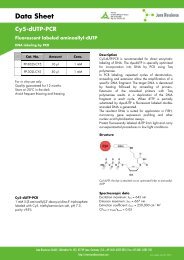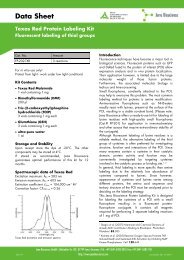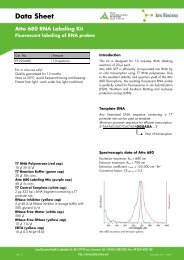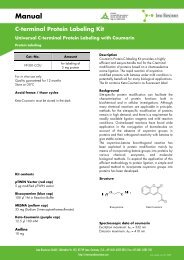Data Sheet - Jena Bioscience
Data Sheet - Jena Bioscience
Data Sheet - Jena Bioscience
You also want an ePaper? Increase the reach of your titles
YUMPU automatically turns print PDFs into web optimized ePapers that Google loves.
<strong>Data</strong> <strong>Sheet</strong><br />
Biotin-X Protein Labeling Kit<br />
Protein Biotinylation Kit<br />
Cat. No. Amount<br />
FP-321 5 reactions<br />
For in vitro use only!<br />
molecular structure of biotin-X NHS-ester<br />
Kit Contents<br />
• Biotin-X NHS-ester<br />
5 vials containing 1 mg each<br />
• Dimethylformamide (DMF)<br />
500 µl<br />
• Sodium bicarbonate<br />
1 vial containing 168 mg<br />
• ultra-pure water<br />
2 ml<br />
Storage and Stability<br />
Upon receipt, store the biotin-X at -20°C. The other<br />
components may be stored at room temperature.<br />
If stored as recommended, <strong>Jena</strong> <strong>Bioscience</strong><br />
guarantees optimal performance of this product for<br />
12 months.<br />
Introduction<br />
Binding of biotin by avidin, streptavidin or<br />
NeutrAvidin TM is the strongest known biological<br />
interaction with a dissociation constant in the range of<br />
10 -15 M.<br />
The vitamin biotin may be conjugated to many<br />
proteins without loss of their biological activity due to<br />
the small size of the biotin molecule. The biotinylated<br />
probe is usually detected by avidin, streptavidin or<br />
NeutrAvidin TM , carrying a reporter group, e.g.<br />
horseradish peroxidase (HRP) or a fluorescent label.<br />
Fluorescent streptavidin (Cat.# FP-303) and avidin<br />
(Cat.# FP-304) assay kits are available from <strong>Jena</strong><br />
<strong>Bioscience</strong>.<br />
The protein of interest (POI) is often biotinylated at<br />
different positions. Each conjugated biotin binds one<br />
molecule of avidin, streptavidin or NeutrAvidin TM ,<br />
resulting in signal amplification.<br />
Biotin-X inserts a C6-spacer between the biotin and<br />
the protein molecule, hence reduces steric hindrance<br />
and increases accessibility for avidin, streptavidin or<br />
NeutrAvidin TM .<br />
The interaction between biotin and biotin-binding<br />
proteins is used in various applications such as affinity<br />
chromatography, fluorescence-activated cell sorting<br />
(FACS), ELISA and Western Blot.<br />
This Protein Biotinylation Kit contains all reagents<br />
required for performing 5 separate labeling reactions<br />
of 5 mg of POI.<br />
Protocol<br />
General notes<br />
The protein concentration should be at least 2 mg/ml,<br />
higher concentrations – up to 10 mg/ml – are<br />
preferable since labeling efficiency suffers from low<br />
concentrations. We recommend using about 5 mg<br />
protein per labeling reaction.<br />
Buffers containing primary amines such as Tris and<br />
glycine are not suitable for the labeling reaction and<br />
must be exchanged with suitable amine-free buffer<br />
such as PBS, MES, or HEPES before starting the<br />
labeling reation.<br />
<strong>Jena</strong> <strong>Bioscience</strong> GmbH | Löbstedter Str. 80 | 07749 <strong>Jena</strong>, Germany | Tel.:+49-3641-6285 000 | Fax:+49-3641-6285 100<br />
Page 1 of 2 http://www.jenabioscience.com Last update: July 2, 2012
<strong>Data</strong> <strong>Sheet</strong><br />
Biotin-X Protein Labeling Kit<br />
Protein Biotinylation Kit<br />
Experimental protocol<br />
1. Dissolve the sodium bicarbonate by adding 2 ml<br />
ultra-pure water. The resulting 1 M solution is<br />
stable at 4°C for at least 2 weeks.<br />
2. Add the appropriate volume of sodium<br />
bicarbonate (1 M) to your protein solution to<br />
achieve a final concentration of 100 mM.<br />
3. Remove one biotin-X vial from the freezer and<br />
equilibrate it to room temperature before opening.<br />
Prepare the biotin-X by adding 100 µl DMF<br />
resulting in a concentration of 10 mg/ml. Vortex<br />
until the biotin-X is completely dissolved! Prepare<br />
the solution shortly prior to use!<br />
4. Add 500 µl protein solution (10 mg/ml) and the<br />
dissolved biotin-X to an appropriate vial. Vortex<br />
carefully and centrifuge briefly to collect the<br />
reaction mixture at the bottom of the tube.<br />
5. Incubate for one hour in a shaker at room<br />
temperature.<br />
6. Purify the conjugate using standard gel filtration<br />
columns such as Sephadex G-25 or similar.<br />
Alternatively, the free biotin-X may be separated<br />
from the conjugate by dialysis or appropriate spin<br />
concentrators.<br />
Please note that protein purification<br />
materials are not provided with the kit!<br />
7. Analyze your conjugate by SDS-PAGE and/or Dot<br />
blot using the fluorescent streptavidin<br />
(Cat.# FP-303) or avidin (Cat.# FP-304) assay kit.<br />
Storage of the Conjugate<br />
Store the conjugate just like the unlabeled protein. We<br />
recommend dividing the solution into small aliquots<br />
and freeze at -20°C or -80°C. Avoid repeated<br />
freezing and thawing!<br />
Troubleshooting<br />
Low biotinylation efficiency<br />
• Concentration of protein solution<br />
The assay is optimized for labeling of 5 mg<br />
protein at a concentration of 10 mg/ml.<br />
The efficiency of biotinylation is strongly<br />
concentration dependent and varies among<br />
different proteins. Thus, in every single case<br />
optimization might be necessary to obtain optimal<br />
biotinylation.<br />
• Buffer composition<br />
Protein solutions containing primary amines (even<br />
traces thereof) dramatically decrease biotinylation<br />
efficiency. Make sure that your protein is<br />
extensively dialyzed in case it has been in contact<br />
with amine-containing substances.<br />
• Impact of the pH<br />
Check the pH of your protein solution! The<br />
reference range is 8.2 – 8.5.<br />
The primary amino groups of the protein must not<br />
be protonated to be reactive thus, the pH of the<br />
protein solution has to be sufficiently high. On the<br />
other hand, the hydrolysis rate of NHS esters<br />
increases with the pH of the solution, resulting in<br />
non-reactive biotin-X. Optimal biotinylation results<br />
have been obtained at pH 8.3.<br />
100 mM sodium bicarbonate might not be<br />
sufficient to raise the pH to optimum in strongly<br />
buffered protein solutions at a lower pH. You may<br />
add more sodium bicarbonate until the optimal<br />
pH is achieved.<br />
Note that biotinylation efficiency not only depends on<br />
the surrounding conditions but also on the protein<br />
characteristics. The tertiary structure and the resulting<br />
number of lysines on the surface of the protein play a<br />
role as well as the isoelectrical point and the<br />
behaviour of the protein at pH 8.3.<br />
For further information and related products, please<br />
visit us at: www.jenabioscience.com<br />
<strong>Jena</strong> <strong>Bioscience</strong> GmbH | Löbstedter Str. 80 | 07749 <strong>Jena</strong>, Germany | Tel.:+49-3641-6285 000 | Fax:+49-3641-6285 100<br />
Page 2 of 2 http://www.jenabioscience.com Last update: July 2, 2012


